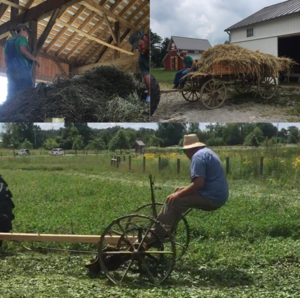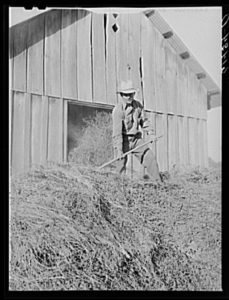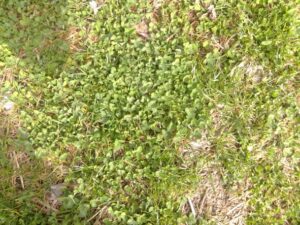By GABE ROSS, Farm Manager
It always seems like you are racing against the rain when making hay in Ohio. Many times I’ve hauled hay into the barn with dark clouds developing in the west and spits of rain hitting my head. That’s when you unload the wagon as fast as possible and thank your lucky stars it’s the last load (hopefully). Sometimes you aren’t that lucky and the hay gets drenched and has to be dried out before putting it up. You want the hay to be as dry as possible so you wait as long as the weather allows.
 For me the labor isn’t the hard part about haymaking, it’s the worry. Decisions such as when to cut, when to rake, and using your best judgement as to how long you think a certain cutting will take to dry can be stressful. Lucky for us, we live in a time when weather radar can be accessed on a phone in our pocket, making things a lot easier. During the 1930s however, there was no such luxury, since weather radar didn’t come into use until after WWII.
For me the labor isn’t the hard part about haymaking, it’s the worry. Decisions such as when to cut, when to rake, and using your best judgement as to how long you think a certain cutting will take to dry can be stressful. Lucky for us, we live in a time when weather radar can be accessed on a phone in our pocket, making things a lot easier. During the 1930s however, there was no such luxury, since weather radar didn’t come into use until after WWII.
We make hay here at Gallant Farm much like it would have been made during the Great Depression, by putting it up loose in the barn rather than in bales. Balers had been invented but it wasn’t until later that they became common on small farms. Putting it up loose means we can put it up with a little more moisture because it isn’t so tightly packed, but it still must be dry enough so that it won’t mold or combust (yet another worry). While you don’t have to hoist heavy bales when putting up loose hay, you do have to do a lot of pitch forking, which can be tiring too. It’s kind of like winding a bunch of spaghetti onto a fork. 
Lightweight two- and three-pronged pitch forks with long handles are the tool of choice to toss hay on top of a tall stack or onto a high pile in a wagon. The four prong forks you see today in hardware and farm stores are for manure or garden work; they are much too heavy and clumsy for haying. If you happen to be at Gallant Farm when we bring in the hay, you can try your hand at forking some onto the wagon.








